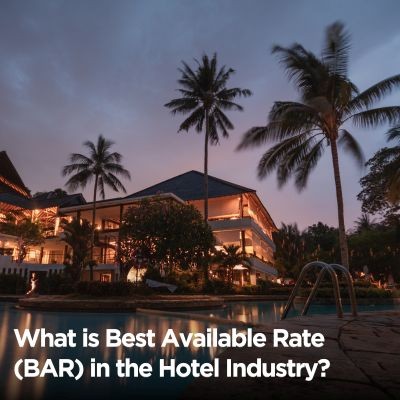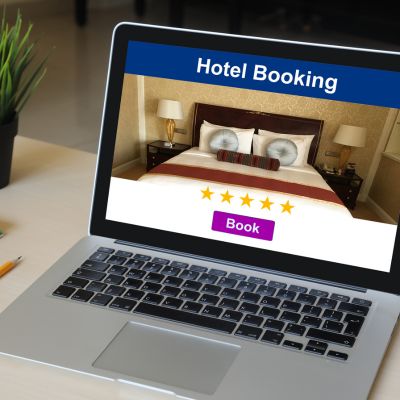Are you tired of using fixed room rates that don’t reflect real-time demand? Traditional pricing strategies often limit hotels with a one-size-fits-all approach, missing out on opportunities to maximize revenue.
In today’s fast-paced hospitality industry, where adaptability is key, sticking to rigid pricing models can lead to lost profitability.
Open pricing offers a solution: Hotels dynamically adjust rates based on room types, customer segments, and distribution channels.
This approach enables tailored pricing based on market conditions instead of flat rates for all guests.
For example, business travelers booking directly through a hotel’s website might get lower rates, while OTAs see higher prices to cover commissions.
When adopting an open pricing strategy, hotels can optimize their revenue per available room (RevPAR) and stay competitive in dynamic markets like Singapore, Bangkok, and Kuala Lumpur.
This article will explore the benefits, challenges, and implementation of open pricing, providing actionable insights for hotels looking to enhance their revenue strategies.
What is Open Pricing in Hotel Revenue Management?

Open pricing is a dynamic approach that allows hotels to set independent rates for hotel distribution channels, customer segments, and room types.
Unlike the traditional Best Available Rate (BAR) model, which sets a uniform price for all guests, open pricing provides the flexibility to tailor prices based on real-time demand, competitor pricing, booking windows, and other market factors.
Let’s say a hotel might adjust its rates higher on OTAs like Booking.com or Agoda, where guests are typically less price-sensitive. To drive more cost-effective reservations, the hotel might offer discounts on direct bookings through its website.
This flexibility is crucial for hotels aiming to maximize revenue from every available room without undercutting their market value.
In a practical scenario, hotels like the Marina Bay Sands in Singapore have significantly utilized open pricing.
Leveraging real-time data and advanced analytics, they can adjust rates according to the specific demands of different market segments, boosting hotel occupancy rates and profitability.
This approach ensures no revenue opportunity is left on the table, even during off-peak periods.
Benefits of Open Pricing for Hotels
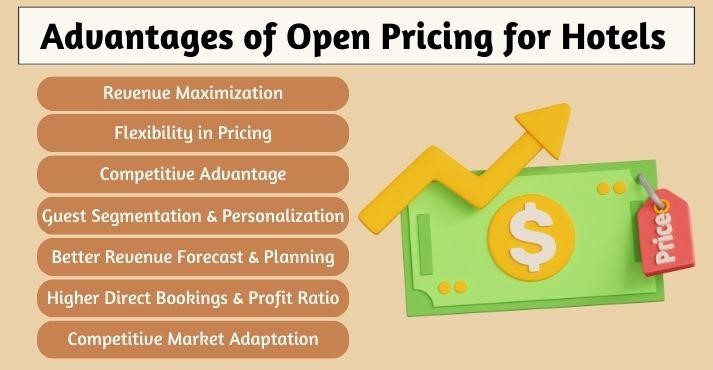
Implementing an open pricing strategy offers several significant benefits to hotels, particularly in markets that experience fluctuating demand and intense competition.
Open pricing is more than just a way to adjust room rates; it’s a comprehensive approach to hotel revenue management that allows fine-tuning hotel pricing strategies in real-time, maximizing profitability and market positioning.
Below, we explore how open pricing develops revenue maximization, pricing flexibility, and competitive advantage.
1. Revenue Maximization
One of the primary benefits of open pricing is its powerful impact on revenue maximization. This strategy enables hotels to optimize their pricing for different customer groups, moving beyond the limitations of one-size-fits-all pricing.
Instead of applying a uniform rate to all bookings, hotels can utilize data-driven insights to tailor prices for each customer segment based on their booking behaviors, preferences, and current market conditions.
Data-driven Decision Making: By leveraging advanced analytics, hotels can more accurately predict demand trends and set the right price at the right time for the right customer. This ensures that hotels can capitalize on peak demand periods, charging premium rates to last-minute or high-demand customers while offering attractive rates to early bookers or loyalty members during quieter times.
This targeted pricing approach ensures that hotels maximize their revenue per available room (RevPAR), a critical metric in hotel revenue management that reflects occupancy and average daily rate performance.
Hotels like the Shangri-La in Bangkok have effectively adopted this dynamic pricing strategy. When utilizing sophisticated revenue management tools, they continuously analyze booking patterns, competitor rates, and event schedules to adjust their pricing dynamically.
2. Flexibility in Pricing
Open pricing is based on flexibility, allowing hotels to adapt their rates to real-time market conditions swiftly.
This flexibility ensures that pricing adjustments are reactive and proactive based on factors such as occupancy rate, average length of stay, booking trends, and external influences like competitor pricing or local events.
The ability to modify rates dynamically means that hotels can optimize their revenue strategy on the fly, making the most out of every market situation.
Channel-specific Pricing: With open pricing, hotels can set different rates for various distribution channels to optimize bookings. For instance, they might lower prices on their direct booking website to encourage more cost-effective direct reservations, which generally have lower acquisition costs than bookings made through online travel agencies (OTAs) that charge higher commission fees.
A great example of this approach is the Grand Hyatt Singapore, which uses a flexible hotel pricing model. By continuously monitoring real-time market conditions and adjusting its rates, it offers competitive pricing to business travelers who typically book last-minute stays.
This adaptability drives higher occupancy rates during fluctuating demand and helps the hotel optimize its revenue streams without sacrificing profitability.
3. Competitive Advantage
In today’s highly competitive hospitality markets, especially in regions like Singapore, Bali, and Manila, hotels must differentiate themselves from their peers.
Implementing an open pricing strategy allows hotels to be more agile and responsive to market changes. They can offer room rates that align closely with guest expectations and current market demands.
This agility is crucial for capturing market share, particularly during high-demand periods or special events.
Unlike traditional pricing models such as the Best Available Rate (BAR), which tends to be static and unresponsive to sudden shifts in demand, open pricing allows hotels to continuously fine-tune their rates to keep them in line with the latest market trends.
This dynamic approach enables properties to stay ahead of competitors relying on fixed pricing structures, providing a unique selling proposition that attracts budget-conscious travelers and premium guests.
4. Enhanced Guest Segmentation and Personalization
An often-overlooked benefit of open pricing is its ability to cater to diverse guest segments with personalized pricing strategies.
When segmenting guests into groups such as leisure travelers, business guests, long-stay visitors, or loyalty program members, hotels can offer tailored rates that resonate with each segment’s specific needs and booking behavior.
For instance:
- Leisure Travelers: Hotels can offer weekend discounts or special package deals during off-peak seasons to attract leisure travelers looking for a getaway.
- Business Travelers: Higher rates can be maintained for business travelers who are less price-sensitive and often require last-minute bookings during weekdays.
This personalized approach increases conversion rates and improves the guest experience, leading to improved satisfaction and loyalty. Guests appreciate knowing that they are receiving offers and rates uniquely suited to their needs, which helps build long-term relationships.
5. Improved Revenue Forecasting and Planning
Open pricing also strengthens a hotel’s ability to forecast revenue more accurately.
Since open pricing relies heavily on data analysis, hotels can develop precise revenue projections based on real-time market conditions, historical booking trends, and competitor activities.
This predictive capability enables better budgeting and resource allocation, ensuring hotels plan effectively for high and low-demand periods.
With a clearer picture of future revenue, hotels can make more informed decisions about staffing levels, marketing investments, and inventory management, ultimately leading to more efficient operations and higher profitability.
6. Increased Direct Bookings and Profit Ratio
Open pricing encourages a strategic focus on increasing direct bookings, which tend to yield higher profits and profit margins than those obtained through third-party platforms.
Hotels can use flexible pricing models to offer exclusive rates or value-added packages to guests who book directly through their website, incentivizing them to bypass OTAs and other commission-based channels.
For instance, offering benefits like free breakfast, room upgrades, or loyalty points for direct bookings can significantly improve guests’ value proposition.
By boosting direct bookings, hotels reduce their distribution costs and build stronger relationships with their customers, promoting brand loyalty and repeat business.
7. Competitive Market Adaptation
Finally, one of the most crucial advantages of open pricing is its ability to help hotels adapt quickly to competitive market conditions.
As the hospitality landscape in regions like Southeast Asia becomes increasingly dynamic, it is vital to be able to adjust rates swiftly in response to competitor pricing moves or sudden changes in demand.
Hotels that employ open pricing can outmaneuver their competitors by reacting in real-time, ensuring they remain attractive to potential guests.
In markets like Bali, where competition among luxury resorts is intense, adopting an open pricing strategy has enabled hotels to stay competitive by continuously tweaking their rates to match or beat their rivals.
Key Components of a Successful Open Pricing Strategy
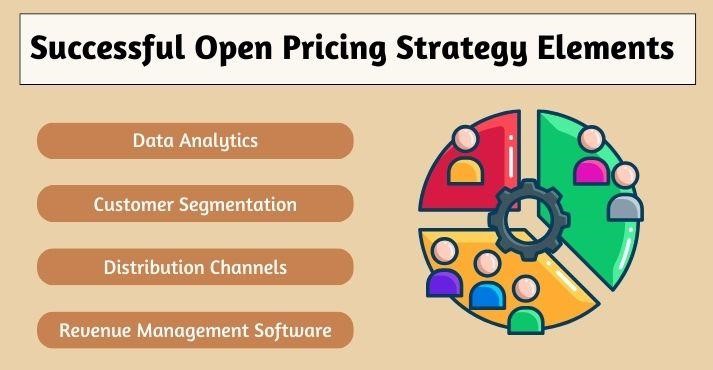
A well-implemented open pricing strategy requires careful consideration of several key components, including data analytics, customer segmentation, distribution channels, and revenue management software.
1. Data Analytics
Effective open pricing relies heavily on robust data analytics. Hotels need to gather and analyze data related to occupancy trends, booking behaviors, seasonal demand, and competitor pricing.
Using AI and machine learning technologies, hotels can more accurately predict demand patterns and adjust their real-time pricing to reflect these insights.
In markets like Singapore, hotels like Marina Bay Sands utilize advanced hotel revenue management systems to analyze vast amounts of data. This allows them to forecast peak booking times and adjust their rates, ensuring they always offer the optimal price to their guests.
2. Customer Segmentation
Segmenting customers is a critical aspect of open pricing that involves categorizing guests into groups based on their booking behaviors and preferences.
Hotels can target specific segments, such as corporate travelers, vacationers, loyalty program members, or long-stay guests, by offering personalized rates that appeal directly to each group.
For example, business travelers who typically book at the last minute might be offered higher rates, while early bird vacationers receive discounts. This tailored approach helps maximize occupancy and profitability by addressing the unique needs of each guest segment.
3. Distribution Channels
A crucial element of open pricing involves differentiating pricing strategies across multiple distribution channels. Hotels should prioritize their direct booking channels, which often have lower costs and higher profit margins than OTAs or the Global Distribution System (GDS).
When strategically setting rates that favor direct bookings, hotels can maximize revenue while reducing dependency on third-party platforms.
Hotels in Southeast Asia, like those in Kuala Lumpur, have successfully implemented this strategy. They offer exclusive rates on their websites while maintaining competitive pricing on OTAs to reach a broader audience.
4. Revenue Management Software
Utilizing hotel revenue management systems is essential for automating the dynamic pricing process. Advanced software solutions can continuously monitor market trends, competitor rates, and booking data, enabling precise rate adjustments without manual intervention.
This automation not only saves time but also increases the accuracy of the pricing strategy.
Properties like the Shangri-La in Jakarta have integrated AI-powered revenue management tools that effortlessly adjust their room rates in response to changing market conditions.
This technology-driven approach ensures their pricing is always competitive and aligned with current demand.
Real-Life Examples of Open Pricing Success
1. Case Study: Marina Bay Sands, Singapore
Marina Bay Sands has set a benchmark in dynamic hotel pricing strategy by leveraging advanced analytics and AI-driven platforms.
During high-demand events like the Singapore Grand Prix or significant conferences, they increase room rates for last-minute bookings while offering loyalty discounts to frequent guests.
This strategy has significantly improved their RevPAR, highlighting the effectiveness of open pricing in capturing market value.
2. Case Study: Shangri-La Bangkok
Shangri-La Bangkok uses a sophisticated hotel revenue management system to analyze real-time booking patterns and competitor rates.
By dynamically adjusting their pricing, they have not only increased their occupancy rates but also maximized profitability during peak tourist seasons.
Their success showcases the potential of open pricing in Southeast Asia’s highly competitive hospitality market.
Implementing Open Pricing: Key Considerations

Implementing an open pricing strategy requires a structured approach that includes data collection, technology integration, pricing rules, and continuous optimization.
Let’s explore these components in more detail to understand how hotels can successfully transition to an open pricing model.
1. Data Collection
Effective open pricing starts with gathering and analyzing a broad range of data points, including historical booking data, occupancy rates, average length of stay, competitor pricing, market demand patterns, and external factors like local events or holidays.
When leveraging this data, hotels can gain valuable insights into customer behavior and market trends, which are crucial for making informed pricing decisions.
For example, hotels in Singapore often collect data on major events like the Singapore Airshow or international conferences to predict spikes in demand.
This allows them to adjust their room rates dynamically, ensuring they maximize revenue during these high-demand periods while offering competitive rates to early bookers.
2. Pricing Rules
Establishing clear pricing rules is essential for the smooth implementation of open pricing. These rules guide adjusting rates based on predefined factors such as booking windows, occupancy levels, and channel-specific demand.
Hotels can create algorithms that automatically update prices in response to real-time market conditions, reducing the need for manual intervention.
For instance, if a hotel’s occupancy rate drops below a certain threshold, the pricing rules can trigger a discount on specific distribution channels like OTAs to boost bookings. Conversely, if demand surges, rates can be increased across direct booking channels to capitalize on the high traffic.
3. Technology Integration
Integrating technology into the open pricing process is crucial for real-time rate adjustments and smooth execution. Hotels should invest in revenue management systems (RMS) that are compatible with their property management systems (PMS).
This integration ensures that room rates are automatically updated across all distribution platforms without delays or inconsistencies.
AI-driven revenue management tools can analyze vast amounts of data and provide actionable insights, allowing hotels to react swiftly to market changes.
Properties like Marina Bay Sands in Singapore have successfully implemented these systems to align their pricing strategies, leading to more accurate rate settings and improved room rate optimization.
4. Testing and Optimization
The final step in implementing open pricing is continuous testing and optimization. Hotels should regularly evaluate the performance of their pricing strategies using A/B testing methods to identify which approaches yield the best results.
When comparing different pricing scenarios, properties can make data-backed decisions that improve their overall pricing strategy.
When continuously refining their pricing models, hotels can ensure they stay competitive and responsive to changing market conditions.
Best Available Rate (BAR) vs. Open Pricing
Understanding BAR
The Best Available Rate (BAR) is a standard pricing strategy where hotels set a fixed rate that applies to all guests, regardless of booking channel or timing. While BAR offers simplicity and consistency, it needs more flexibility to adapt to market changes, often resulting in missed revenue opportunities.
Limitations of BAR
One of the most significant drawbacks of relying on BAR is its rigidity. Hotels using BAR may need more time to adjust their rates during high-demand periods to maximize revenue.
Instead, they might have to resort to significant discounts in low-demand periods, which can devalue their brand and reduce profitability.
Comparing BAR to Open Pricing
In contrast, open pricing allows hotels to adjust rates in real-time based on demand, distribution channels, and guest profiles.
This approach allows hotels to optimize their pricing strategy for each booking scenario, ensuring they extract the maximum possible value from every guest.
Unlike BAR, which sets the same price for everyone, open pricing is dynamic and continuously adjusts to reflect current market conditions.
Challenges in Implementing Open Pricing
While open pricing offers significant benefits, it also has challenges that hotels must address to ensure a smooth transition and successful implementation.
1. Operational Complexity
Managing multiple price points across different segments and distribution channels can be complex.
Open pricing requires strong coordination between various departments, including revenue management, hotel sales strategy, marketing and branding, and operations.
Any misalignment in these areas can lead to pricing errors or inconsistencies that might confuse customers and affect the hotel’s brand image.
To overcome this challenge, hotels should invest in team training and ensure that all departments understand the goals and mechanics of their open pricing strategy. Clear communication and a well-defined process will help maintain consistency and accuracy in rate adjustments.
2. Technological Investments
Open pricing often requires significant investment in advanced technology, such as AI-powered revenue management systems and data analytics tools. Smaller or independent hotels may find these costs prohibitive, limiting their ability to fully capitalize on open pricing benefits.
However, even with a limited budget, hotels can explore cost-effective software solutions that offer basic dynamic pricing capabilities. They can gradually scale up to more sophisticated systems that provide deeper insights and automation as they grow.
3. Customer Perception
Another challenge of open pricing is managing customer expectations and perceptions. Guests who book at different times or through various channels may encounter different rates, leading to confusion or dissatisfaction if not communicated properly.
To mitigate this issue, hotels should be transparent about their pricing policies, clearly explaining how rates vary based on demand and booking conditions.
By educating guests about the benefits of booking directly through the hotel’s website, hotels can encourage more direct bookings and increase customer loyalty.
Future Trends in Open Pricing
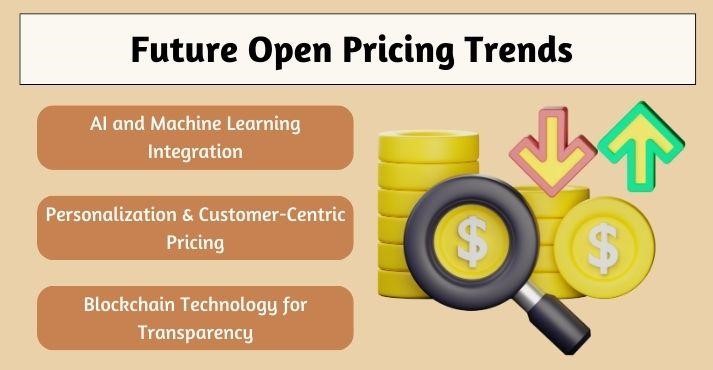
Open pricing is expected to evolve as technology advances, offering even more sophisticated hotel tools to optimize revenue. Here are some key trends shaping the future of open pricing in the hospitality industry:
1. AI and Machine Learning Integration
AI and machine learning are set to play pivotal roles in the next generation of hotel revenue management systems. These technologies can analyze massive data sets to accurately predict booking trends, customer behavior, and market demand.
When leveraging AI, hotels can automate much of their pricing strategy, reducing the risk of human error and ensuring optimal pricing at all times.
2. Personalization and Customer-Centric Pricing
Future open pricing strategies will likely focus on personalization, with rates tailored to individual guests based on their preferences, booking history, and loyalty status.
For instance, returning guests might receive special rates or packages that specifically address their needs, increasing customer satisfaction and repeat bookings.
3. Blockchain Technology for Transparency
Blockchain technology can transform how hotels manage their distribution channels and pricing transparency.
When creating a decentralized system, hotels can offer more secure and transparent transactions, reducing the chances of rate discrepancies across different platforms. This innovation will help build greater trust among guests and partners.
Conclusion
In the rapidly evolving hospitality industry, open pricing is a game-changer for hotels aiming to maximize revenue and stay competitive.
By moving away from static models like the Best Available Rate (BAR) and incorporating a more dynamic approach, hotels can tailor their rates to meet the market’s ever-changing demands.
Through the effective use of data analytics, AI-driven tools, and a customer-centric approach, properties can augment their RevPAR and deliver more personalized experiences to their guests.
As the industry continues to adopt new technologies, the future of open pricing in hospitality looks promising. Hotels that can successfully implement these strategies will outperform their competitors and set a new standard for excellence in revenue management.
Adopting this approach is no longer just an option; it’s necessary for any hotel looking to thrive in today’s competitive landscape.



